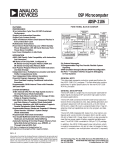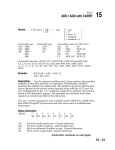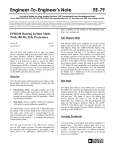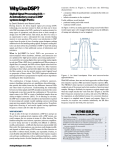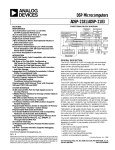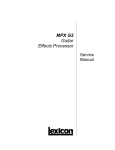Download Converting Legacy 21xx Systems To A 218x System Design
Transcript
Engineer To Engineer Note EE-48 Technical Notes on using Analog Devices’ DSP components and development tools Phone: (800) ANALOG-D, FAX: (781) 461-3010, EMAIL: [email protected], FTP: ftp.analog.com, WEB: www.analog.com/dsp Copyright 1999, Analog Devices, Inc. All rights reserved. Analog Devices assumes no responsibility for customer product design or the use or application of customers’ products or for any infringements of patents or rights of others which may result from Analog Devices assistance. All trademarks and logos are property of their respective holders. Information furnished by Analog Devices Applications and Development Tools Engineers is believed to be accurate and reliable, however no responsibility is assumed by Analog Devices regarding the technical accuracy of the content provided in all Analog Devices’ Engineer-to-Engineer Notes. Converting Legacy 21xx Systems To A 218x System Design Last Modified: 3/31/99 Introduction This EE-Note will explain how to convert an existing 21xx family processor design to a 218x compliant design. The main differences are with the system builder and architecture files, the prom splitter, and the actual booting process of the DSP. Some example code will be shown for both the legacy 21xx systems and for the updated 218x system, as well as an example of how the prom splitter utility (spl21.exe) is utilized to generate a bootable image for a 218x system. The examples included in this application note are built using version 6.1 of the 2100 family development tools, which currently is the latest version. The System Builder The system builder (as we all know) is where we define the memory map for our processor. An important fact to point out at this time, is that the system builder only knows about a maximum of 16k words of PM and DM, since the processor is limited to 14 bits of internal addressing in the DAG registers. So, for a 21xx system, you would declare both your internal and external memory in the *.sys file. For a 218x system, the *.sys file declares internal memory locations only; the external memory locations are not declared here. The use of hardware memory overlays on the 218x processors is utilized during runtime only. (Currently, the 2100 family development tools work with a maximum of 16k words of declared PM and DM memory.) For a 218x system, the development tools do not require the declaration of EPROM boot pages in the system files and assembly source. This is contrary to the 21xx designs, in which it was necessary to define your boot segments in the source and system files to generate a bootable image file. Figure 1 shows an example 2111 system file that declares 2k words of PM memory and 1k words of DM, and a boot page, which contains 2k bytes of information. Figure 2 shows an example 2187L system file. Note that although the 2187L has 32k words of internal PM and DM respectively, only 16k words of each is declared in this system file. The additional on-chip memory is located in overlays, which will be explained later in this application note. For more information on hardware overlays, please refer to the appropriate 218x datasheet. .system Example_2111_System_File; .adsp2111; .mmap0; .seg/pm/ram/code/data/abs=0 int_pm[0x800]; .seg/pm/ram/code/data/abs=0x800 ext_pm[0x37ff]; .seg/dm/ram/data/abs=0x3800 .seg/dm/ram/data/abs=0 int_dm[0x3ff]; ext_dm[0x3800]; .seg/rom/boot=0 .port/dm/abs=0x0400 .port/dm/abs=0x0401 boot0[2048]; a_d_sample_in; a_d_sample_out; .endsys; Figure 1: Example 2111 system file .system .adsp2181; .mmap0; Example_2187L_System_File; .seg/pm/ram/code/data/abs=0 int_pm[0x2000]; .seg/pm/ram/code/data/abs=0x2000 ovl_pm[0x2000]; .seg/dm/ram/data/abs=0 .seg/dm/ram/data/abs=0x2000 .endsys; ovl_dm[0x2000]; int_dm[0x1FE0]; a {System File Excerpt} .port/dm/abs=0x0400 Figure 2: Example 2187L system file For the 2187L system example, please note the omission of the boot page declarations, “.port” declarations, and the omission of the upper 32 DM memory locations (DM0x3fe0-0x3fff) for the memory-mapped control registers. For more information on these registers, please refer to the 2100 family user’s manual. We’ll discuss the negation of the .port directive in a 218x system design later in this application note. a_d_sample_in; {Assembly File Excerpt} ax0=dm(a_d_sample_in); Figure 3: 2111’s use of “.port” declaration {218x Assembly File Excerpt} .const a_d_sample_in=0x400; . . ax0=io(a_d_sample_in); Assembly Source Changes Figure 4: 218x use of memory mapped I/O Now that you’ve seen the differences in the system builder, let’s delve further into this and look at the changes in the assembly source code for a 218x system. The main differences here are that again, boot pages need not be declared for a 218x system design Please note the omission of any “.port” references in the 218x system file. The development tools will generate an error message when trying to generate a build with “.port” declarations in a 218x system file. For more information on the I/O assembly instruction, please refer to page 15-74 of the 2100 family user’s manual, third edition, or the appropriate adsp218x datasheet. Let’s start off with the “.module” declaration, which signifies the beginning of an assembly file. Here is a listing for a 2111 assembly source file: .module/ram/abs=0/boot=0 .module/ram/abs=0/boot=0 Example_2111_Program; Example_2111_Program; Here, we notice the inclusion of the boot page qualifier. Since the 2100 family tools do not use boot pages for a 218x system, we can easily see the changes needed: .module/ram/abs=0 Example_2187L_Program; .module/ram/abs=0 Example_2187L_Program; Memory Mapped I/O Ports The 218x family processors use a different scheme for defining memory mapped I/O than the rest of the 21xx family processors. The addition of the I/O memory space, with its 2048 memory locations, allows for the mapping of multiple memory-mapped devices (with different access speeds) instead of mapping the I/O device using external data memory. This scheme allows you to use the full 16k words of on-chip PM and DM and still have the additional 2k locations of 16-bit I/O memory. For example, here’s an excerpt from our 2111 system and source files; EE-48 ADSP-218x Memory Variants Since the system builder is ignorant to any of the 218x memory variant processors, we need to “trick” the tools to work for us when dealing with these processors. Here is a listing of all of the 218x processors currently available: Figure 5: Listing of 218x Memory Variant Processors Processor adsp2181 adsp2183 adsp2184 adsp2184L adsp2185 adsp2185L adsp2186 adsp2186L adsp2187L adsp2189M Memory (PM/DM) 16k/16k 16k/16k 4k/4k 4k/4k 16k/16k 16k/16k 8k/8k 8k/8k 32k/32k 32k/48k #Pins Volts 128 5v 128 3.3v 100 5v 100 3.3v 100 5v 100 3.3v 100 5v 100 3.3v 100 3.3v 100 2.5/3.3v* Basically, all we need to do in our system file is to declare the appropriate memory segments for our specific processor, while still using the “.adsp2181;” directive. For Page 2 Technical Notes on using Analog Devices’ DSP components and development tools Phone: (800) ANALOG-D, FAX: (781) 461-3010, EMAIL: [email protected], FTP: ftp.analog.com example, let’s define a system file for a 2186 processor, which has 8k words of internal PM and DM respectively. .system Example_2186_System_file; .adsp2181; .mmap0; .seg/pm/ram/code/data/abs=0x0000 int_pm[0x2000]; .seg/dm/ram/data/abs=0x2000 int_dm[0x1fe0]; .endsys; Again we see that there are no memory declarations for the external overlay memory that is supported by the 218x processors. The system file should only contain declarations for on-chip memory; no external memory should be declared. (Please note here that the “memory variant” directive, MV, is not supported by the v6.1 development tools. When using a 2181 memory variant processor, simply use the “.adsp2181;” qualifier.) This is contrary to the other 21xx processors, because these processors contained up to 2k words of on-chip memory. This allowed the addressing capability of the DAG registers to access internal and external memory as a “flat” memory model., meaning no memory overlays were needed to access the additional memory with only 14-bits of addressing capability. (Remember, 214=16,384 or 16k.) For more information on memory overlays, please refer to sections 10.6.1 and 10.6.2 of the 2100 family user’s manual, third edition. The PROM Splitter Utility The latest PROM splitter for the 2100 family development tools (v6.1) includes what is called a loader, which is a 32word kernel that gets booted initially into the DSP. To configure a 218x DSP for EPROM boot mode, the DSP’s MMAP and BMODE pins should be set to zero for the 2181/3 processors, and the MODEA and MODEB pins should be set to zero for the 2184/5/6/7/9 processors. (For more information on the configuration of these pins, please refer to the appropriate processor data sheet.) is a listing of the complete 113-word loader. If there is no PM or DM code for a particular page, the 9-word loader code for that specific page is replaced with NOP instructions. The loader then initializes data memory by loading the high-order byte (of the 16-bit DM word) first, then the low-order byte is loaded. For program memory initialization, the DSP loads PM memory in the following order, high-byte, middle-byte, low-byte. Included in the appendix of this engineer’s note will be an example output of the PROM splitter highlighting the format of the loader routine. 32-word loader code 9-word loader code for DM page 0 9-word loader code for DM page 1 9-word loader code for DM page 2 9-word loader code for PM page 5 9-word loader code for PM page 4 9-word loader code for PM page 3 9-word loader code for PM page 2 9-word loader code for PM page 1 9-word loader code for PM page 0 Again, this feature is different from the rest of the 21xx family, where you had to explicitly define which boot page your code or data segment resided in your source code. To generate an EPROM image file from your executable, invoke the PROM splitter utility with the following command line switches: spl21 input_file output_file –2181 -loader Here, the file named input_file is the name of your executable file (*.exe) and the output_file is the name of the output file generated by the splitter utility, with a .bnm prefix. For example, the following command line will generate an EPROM image named fft_boot.bnm from the executable file fft.exe; Spl21 fft fft_boot –2181 -loader After reset, the 218x processor is configured by default to load in the first 96 bytes from the EPROM (which corresponds to the first 32 program memory locations) which is the loader kernel. This loader kernel configures the appropriate BDMA registers to initialize all of the onchip memory locations used by your program. The loader kernel performs the memory initialization by loading in 81 program memory words that contain initialization code for each of the 9 “page” loaders. Below EE-48 The inclusion of the –2181 and –loader switches instructs the PROM splitter utility to generate a 218x “friendly” output file, which works in conjunction with the booting process of the 218x processor. (There is also support for the –loader switch for the rest of the 2100 family processors. Please refer to the development tools release notes for more information.) Page 3 Technical Notes on using Analog Devices’ DSP components and development tools Phone: (800) ANALOG-D, FAX: (781) 461-3010, EMAIL: [email protected], FTP: ftp.analog.com More Architecture File Examples Included below are some architecture file definitions for the various 218x memory variant processors. These processors are broken up into two main groups; processors having at least 16k words of on-chip memory, and processors with less than 16k words of memory. .system .adsp2181; .mmap0; Example_218x_System_File; int_pm[0x4000]; int_dm[0x3fe0]; .endsys; Figure 6: Architecture file definition for 2181/3/5/7L/9M systems Example_2186_System_File; .seg/pm/ram/code/data/abs=0 .seg/pm/ram/data/abs=0 int_pm[0x2000]; int_dm[0x1fe0]; .endsys; Figure 7: Architecture file definition for a 2186 system .system .adsp2181; .mmap0; Additional Constants for ALU Operations A new set of numerical constants may be used in all nonmultifunction ALU operations (except DIVS) using both X and Y operands. The instruction source code is specified as follows: Syntax: [IF condition] .seg/pm/ram/code/data/abs=0 .seg/pm/ram/data/abs=0 .system .adsp2181; .mmap0; processors. The term “base instruction set” refers to the computations and instructions available on all ADSP-21xx processors. | AR | = xop function | yop | | AF | | constant | Permissible xops: AX0, AX1, AR, MR0, MR1, MR2, SR0, SR1 Permissible functions: ADD, ADD with CARRY, SUBTRACT X-Y, SUBTRACT X–Y with BORROW, SUBTRACT Y–X, SUBTRACT Y–X with BORROW, AND, OR, XOR Permissible yops (base instruction set) AY0, AY1, AF Permissible yops and constants (extended instruction set) AY0, AY1, AF, 0, 1, 2, 4, 8, 16, 32, 64, 128, 256, 512, 1024, 2048, 4096, 8192, 16384, 32767, -2, -3, -5, -9, -17, -33, -65, -129, -257, -513, -1025, -2049, -4097, -8193, -16385, -32768 Examples: AR=AR+1; AR=MR1 - 33; IF GT AF=AX1 OR 16; Example_2184_System_File; .seg/pm/ram/code/data/abs=0 .seg/pm/ram/data/abs=0x2000 int_pm[0x1000]; int_dm[0x1000]; .endsys; Figure 8: Architecture file definition for a 2184 system Description: Test the optional condition and, if true, perform the specified function. If false, then perform a no-operation. Omitting the condition performs the function unconditionally. The operands are contained in the data registers specified in the instruction, or optionally a constant may be used. Additional Constants for ALU PASS Operation A new set of numerical constants may be used in the PASS instruction. The instruction source code is specified as follows: Extended ALU Operations The following extended computation operations are available only on the ADSP-2171 and ADSP-2181 EE-48 Syntax: [IF condition] | AR | = pass | yop | AF | constant | Page 4 Technical Notes on using Analog Devices’ DSP components and development tools Phone: (800) ANALOG-D, FAX: (781) 461-3010, EMAIL: [email protected], FTP: ftp.analog.com | AF | | SETBIT n of xop; | | CLBIT n of xop; | | TGBIT n of xop; | Permissible yops (base instruction set) AY0, AY1, AF Permissible xops AX0, AX1, AR, MR0, MR1, MR2, SR0, SR1 Permissible yops and constants (extended instruction set) AY0, AY1, AF, 0, 1, 2, 3, 4, 5, 7, 8, 9, 15, 16, 17, 31, 32, 33, 63, 64, 65, 127, 128, 129, 255, 256, 257, 511, 512, 513, 1023, 1024, 1025, 2047, 2048, 2049, 4095, 4096, 4097, 8191, 8192, 8193, 16383, 16384, 16385, 32766, 32767, -1, -2, -3, -4, -5, -6, -8, -9, -10, -16, -17, -18, -32, -33, -34, -64, -65, -66, -128, -129, -130, -256, -257, -258, -512, -513, -514, -1024, -1025, -1026, -2048, -2049, -2050, -4096, -4097, -4098, -8192, -8193, -8194, -16384, -16385, -16386, -32767, -32768 Example: IF GE AR = PASS AY0; IF EQ AF = PASS -1025; Description: Test the optional condition and, if true, pass the source operand unmodified through the ALU block and store in the destination location. If the condition is not true, perform a no-operation. Omitting the condition performs the pass unconditionally. The source operand is contained in the data registers specified in the instruction or optional constant. The PASS instruction performs the transfer to the AR register and affect the status flag; this instruction is different from a register move operation which does not affect any status flags. PASS 0 is one method of clearing AR. PASS 0 can also be combined in a multifunction instruction in conjunction with memory reads and writes to clear AR. Note: The ALU status flags (in the ASTAT register) are not defined for the execution of this instruction when using the constant values other than 0, 1, and -1. Permissible n Values (0 = LSB) 0, 1, 2, 3, 4, 5, 6, 7, 8, 9, 10, 11, 12, 13, 14, 15 Examples: AF=TSTBIT 5 of AR; IF NE JUMP SET; /* JUMP TO SET IF BIT IS SET */ Definitions of Operations TSTBIT is an AND operation with a 1 in the selected bit SETBIT is an OR operation with a 1 in the selected bit CLBIT is an AND operation with a 0 in the selected bit TGBIT is an XOR operation with a 1 in the selected bit Result-Free ALU Operations The result-free ALU operations allow the generation of condition flags based on an ALU operation but discard the result. The source code for the instruction is specified as follows: Syntax: NONE = <ALU>; Where <ALU> is any unconditional ALU operation of the 21xx base instruction set (except DIVS or DIVQ). (Note that the additional constant ALU operations of the 21xx extended instruction set are not allowed.) Examples: NONE = AX0 – AY0; NONE = PASS SR0; Description: Perform the designated ALU operation, set the condition flags, then discard the result value. This allows the testing of register values without disturbing the AR or AF register values. ALU Bit Operations The additional constants for ALU operations allow you to code bit test, set, clear, and toggle operations through careful choice of the constant and ALU function. For streamlined programming, the source code for these operations can also be specified as: Syntax: EE-48 [IF condition] | AR | = | TSTBIT n of xop; | Page 5 Technical Notes on using Analog Devices’ DSP components and development tools Phone: (800) ANALOG-D, FAX: (781) 461-3010, EMAIL: [email protected], FTP: ftp.analog.com Appendix A: Example Source File Listing Here is a simple assembly program that adds two numbers stored in data memory: .module example1; .var/dm/ram/abs=0x10 x; .init x: 0x7; .var/dm/ram/abs=0x11 y; .init y: 0x21; start: ax0 = dm(x); ay0 = dm(y); ar = ax0 + ay0; .endmod; After the program is assembled and linked, the .BNM file generated in Intel S Record format by executing the PROM splitter with the -2181 and -loader switches is shown below: S22500000040060093FE2040020093FE1040000093FE3040087093FE403C008C0000003C0083EF S22500002102800018020F0000000000000000000000000000000000000000000000000000000E S2250000420000000000000000000000000000000000000A001F000000000000000000401F50C0 S22500006393FE2040010093FE1040001093FE3040002093FE4002800000000000000000000020 S22500008400000000000000000000000000000000000000000000000000000000000000000056 S2250000A500000000000000000000000000000000000000000000000000000000000000000035 S2250000C600000000000000000000000000000000000000000000000000000000000000000014 S2250000E7000000000000000000000000000000000000000000000000000000000000000000F3 S225000108000000000000000000000000000000000000000000000000000000000000000000D1 S225000129000000000000000000000000000000401F9093FE2040000093FE1040008093FE30AE S22500014A40003093FE40028000000000000000000000000000000000000000000000000000CC S22500016B0000000000000000000000000000000000000000000000000000000000000000006E S22500018C0000000000000000000000000000000000000000000000000000000000000000004D S2250001AD0000000000000000000000000000000000000000000000000000000000000000002C S2250001CE0000000000000000000000000000000000000000000000000000000000000000000B S2250001EF0000000000000007002180010080011422600FFFFFFFFFFFFFFFFFFFFFFFFFFFFF29 S9030000FC The program and data words are shown in bold; the other characters are Intel S Record-related. In the following listing, the program and data words are disassembled and described (please note the inclusion of only 2 boot pages; 1 PM page and 1 DM page): EE-48 Page 6 Technical Notes on using Analog Devices’ DSP components and development tools Phone: (800) ANALOG-D, FAX: (781) 461-3010, EMAIL: [email protected], FTP: ftp.analog.com PM/DM Word Instruction 400600 93FE20 400200 93FE10 400000 93FE30 400870 93FE40 3c008c 000000 3c0083 028000 18020F 000000 000000 000000 000000 000000 000000 000000 000000 000000 000000 000000 000000 000000 000000 000000 0A001F 000000 000000 000000 ax0 = 0x0060 dm(BEAD) = ax0 ax0 = 0x0020 dm(BIAD) = ax0 ax0 = 0x0000 dm(BDMAC) = ax0 ax0 = 0x0087 dm(BWCOUNT) = ax0 ifc = 0x008 nop imask = 0x08 idle jump 0x20 nop nop nop nop nop nop nop nop nop nop nop nop nop nop nop rti nop nop nop 401F50 93FE20 400100 93FE10 400010 93FE30 400020 93FE40 028000 ax0 = 0x01f5 dm(BEAD) = ax0 ax0 = 0x0010 dm(BIAD) = ax0 ax0 = 0x0001 dm(BDMAC) = ax0 ax0 = 0x0002 dm(BWCOUNT) = ax0 idle 000000 000000 nop nop EE-48 Comments Start of 32 word loader load in 96 words of loader kernel (32 x 3) load in the code past the original boot set btype = 0, bcr = 0, bmpage = 0, and bdir = 0 size of byte loader code clears pending BDMA interrupt 1 cycle latency in setting IFC wait for BDMA transfer to finish start of loader code is at PM0x0020 BDMA interrupt vector Start of DM Page 0 Loader start of DM code set btype = 1, bcr = 0, bmpage = 0, and bdir = 0 count of dm code on bm page 0 wait for BDMA transfer to finish Start of DM Page 1 Loader Page 7 Notes on using Analog Devices’ DSP components and development tools from the DSP Division Phone: (800) ANALOG-D, FAX: (781) 461-3010, EMAIL: [email protected], FTP: ftp.analog.com 000000 000000 000000 000000 000000 PM/DM Word nop nop nop nop nop Instruction 000000 000000 nop nop 000000 000000 000000 000000 000000 000000 000000 000000 000000 nop nop nop nop nop nop nop nop nop 000000 000000 000000 000000 000000 000000 000000 000000 000000 nop nop nop nop nop nop nop nop nop 000000 000000 000000 000000 000000 000000 000000 000000 000000 nop nop nop nop nop nop nop nop nop 000000 000000 000000 000000 000000 000000 000000 000000 000000 nop nop nop nop nop nop nop nop nop 000000 000000 nop nop Comments Start of DM Page 2 Loader Start of PM Page 5 Loader Start of PM Page 4 Loader Start of PM Page 3 Loader Start of PM Page 2 Loader EE-48 Page 8 Notes on using Analog Devices’ DSP components and development tools from the DSP Division Phone: (800) ANALOG-D, FAX: (781) 461-3010, EMAIL: [email protected], FTP: ftp.analog.com 000000 000000 000000 000000 000000 PM/DM Word nop nop nop nop nop Instruction 000000 000000 nop nop 000000 000000 000000 000000 000000 000000 000000 000000 000000 nop nop nop nop nop nop nop nop nop 401F90 93FE20 400000 93FE10 400080 93FE30 400030 93FE40 028000 ax0 = 0x01f9 dm(BEAD) = ax0 ax0 = 0x0000 dm(BIAD) = ax0 ax0 = 0x0008 dm(BDMAC) = ax0 ax0 = 0x0003 dm(BWCOUNT) = ax0 idle Comments Start of PM Page 1 Loader Start of PM Page 0 Loader address of PM code in external byte memory starting internal PM address of code set btype = 0, bcr = 1, bmpage = 0, and bdir = 0 count of pm code on bm page 0 (3-PM instructions) wait for BDMA transfer to finish Here is a listing of the actual code in memory after the processor has completed the booting process; Data 800100 800114 22600F uuuu uuuu uuuu uuuu uuuu uuuu uuuu uuuu uuuu uuuu uuuu uuuu EE-48 Instruction ax0 = dm (0x0010) ay0 = dm (0x0011) ar = ax0 + ay0 Memory Location pm[0x0] pm[0x1] pm[0x2] dm[0x0] dm[0x1] dm[0x2] dm[0x3] dm[0x4] dm[0x5] dm[0x6] dm[0x7] dm[0x8] dm[0x9] dm[0xa] dm[0xb] Page 9 Notes on using Analog Devices’ DSP components and development tools from the DSP Division Phone: (800) ANALOG-D, FAX: (781) 461-3010, EMAIL: [email protected], FTP: ftp.analog.com uuuu uuuu uuuu uuuu 0007 0021 EE-48 dm[0xc] dm[0xd] dm[0xe] dm[0xf] dm[0x10] dm[0x11] Page 10 Notes on using Analog Devices’ DSP components and development tools from the DSP Division Phone: (800) ANALOG-D, FAX: (781) 461-3010, EMAIL: [email protected], FTP: ftp.analog.com











